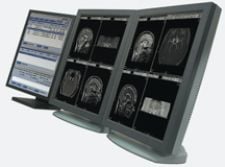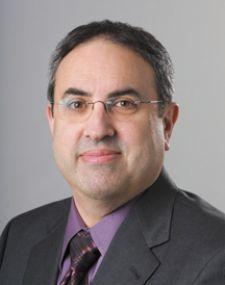
Mark Leavitt, M.D., Ph.D., is chair of the Certification Commission for Healthcare Information Technology.
Integrating disparate systems poses serious challenges to healthcare as information silos separate clinical information flow amongst radiology, oncology, cardiology and more.
Over the years, radiology has led the way in breaking down these silos and linking them across the enterprise. Now, radiology is again positioned to play the lead role in connecting imaging data sets and clinical information networks into a single national electronic health record (EHR).
“Imaging departments were the first in healthcare to benefit from effective interoperability standards that began at the diagnostic modality level, expanded to the radiology department level with the emergence of PACS and then RIS systems, and then beyond the department to interoperate with the hospital’s enterprise IT system,” said Charles Parisot, who leads GE Healthcare’s global standards and health information exchange technology strategy. “This was achieved in the late 90’s thanks to the DICOM standard, with full workflow integration accomplished through Integrating the Healthcare Enterprise (IHE) specifications based on DICOM and HL7. The IHE’s use of case-based process was a major accomplishment, laying the foundation to now link the digital imaging department to community wide or nationwide network for imaging information exchange.”
In late 2005, IHE completed specifications to support cross-enterprise document sharing for imaging (XDS-I), and early product implementations are ready for demonstration at RSNA in November 2006. “IHE XDS-I establishes the foundation for the imaging component of a virtual nationwide EHR. Given imaging’s historical leadership in electronic information workflow, one should expect imaging to lead this upcoming revolution in healthcare information sharing,” added Parisot, who also co-chair’s IHE IT Infrastructure Committee.
Once medical imaging and IT systems demonstrate their interoperability through the IHE program, the next step is to link them to an enterprise-wide electronic health record (EHR). At this stage, many EHR providers may opt to go through a new certification process administered by The Certification Commission for Healthcare Information Technology (CCHIT), a national certification body inspecting electronic health record (EHR) systems. CCHIT runs a battery of tests on EHR systems, and for those that make the grade, issues a CCHIT seal of approval.
“This important step in the healthcare industry indicates a shift in the market that may help reduce risk for physicians and encourage more practices to consider adoption,” said Vishal Wanchoo, president and CEO of GE Healthcare Integrated IT Solutions. “With so many EHR vendors in the industry and a trend towards consolidation, we believe that certification will set us apart as a vendor capable of meeting the dynamic needs of physicians, patients and the healthcare industry as a whole.”
Christopher Crow, M.D., MBA, and founder of Family Medical Specialists of Texas, also believes that CCHIT certification is a major step in the right direction for EHR vendors. “Our investment in a system which has already received a seal of approval from CCHIT gives our organization a greater degree of comfort in our choice,” said Dr. Crow. “The...use of established standards not only paves the way for interoperability with other systems, but gives us the opportunity to easily participate in these emerging pay-for-performance programs.”
CCHIT Grants First EHR Certifications
The role of the commission is to accelerate the adoption of robust, interoperable electronic health records to improve the quality, safety and efficiency of healthcare.
“This seal of certification removes a significant barrier to wide-spread adoption of electronic health records. It gives healthcare providers peace of mind to know they are purchasing a product that is functional, interoperable and will bring higher quality and safer care to patients,” said Mark Leavitt, M.D., Ph.D., Chair of the Certification Commission for Healthcare Information Technology.
To further probe the purpose and impact that the CCHIT seal will have on medical imaging and healthcare IT, Imaging Technology News (ITN) asked CCHIT leader Dr. Leavitt.
ITN: You mentioned that this seal of certification removes a barrier to the adoption of electronic health records. What exactly has posed a barrier for health systems?
Dr. Leavitt: The barrier is the risk that physicians faced in choosing and implementing an EHR. They say, what if I buy it and it doesn’t work; it is not compatible with other systems; it doesn’t connect up to this new network that is forming. Or they will say, what if it ends up being betamax in a VHS world? We’re taking the first step now in reducing that risk through certification.
ITN: Are you finding that a lot of facilities are waiting to see how the EHR systems fair with others before they make that investment?
DL: That’s what they used to do before certification. They would make the vendor come back for three or four demonstrations over literally years sometimes. That should change now, and that is going to actually make the industry and the marketplace operate more efficiently.
ITN: Can you elaborate on how it will make it operate more efficiently?
DL: A couple of things, first of all, the physicians should be able to move more quickly to the final evaluation. Maybe they want to look at three or four products and see which fits them best. There are more than 200 vendors with an ambulatory EHR. So it gets them to a more advanced stage more quickly.
Second, they can assume from the certification that the criteria are covered, and they can focus on what is really important to their individual office. They are going to be able to do that evaluation more efficiently.
ITN: What is the standard that will be established for security features?
DL: If you look at our current criteria, you will see there are a number of security requirements such as the requirement for path, the requirement for being able to set up policy to update their passwords at some interval, the requirement that there be an audit trail of all accesses to the record, that there be a method for backing up the data — all of those are security requirements that are now in our criteria.
ITN: I see that you have several large and small vendors who have received certification. What does the process entail and when did they start participating in this?
DL: Vendors engaged with us from the very start, and the start of CCHIT was really the fall of 2004. The actual testing is more on the order of a day or two, although it is pretty intense. They are going through a scripted scenario, and they have jurors watching this over a Web conferencing system.
ITN: Will the venders be using this as a marketing instrument, and how so?
DL: They absolutely should be able to do that. It is intended for that purpose. They are allowed to reproduce a seal, which they can apply to any of their products or literature that says CCHIT Certified, and it also specifies the year because remember our criteria are updated every year.
ITN: Is there an investment that the vendors have to make in order to be certified?
DL: Yes, there is a fee. The first year is $28,000. Year two and year three, if they want to keep marketing it and not retest, it is $4,800 each year.
ITN: What is the ROI for the vendor?
DL: If [the certification] accelerates the adoption of electronic health records, that translates into increased sales of electronic health records by the certified vendors. We would like to wait and see what happens. We believe it will have a significant affect. That is one ROI, increased sales.
There is a second ROI. I personally think it will reduce their sales cycle time as well as sales expenses somewhat.
ITN: In what year do you see 50 percent of medical facilities using an EHR?
DL: About 14 to 17 percent of physicians are using an EHR, and EHR might be within a RHIO, it’s not going to be connected. I think achieving 50 percent by 2014 is achievable.
Almost no EHRs right now are connected because there are very few RHIOs — the percentage is way less than 14 to 17 percent. The percentage of physicians who have an EHR that is connected to a RHIO is probably under 1 percent now. That will change; that one I find harder to predict. If you talk about EHRs being adopted compared with the current 14 to 17 percent, getting to 50 percent by 2014 is very achievable, and I think it will have a significant, positive impact.



